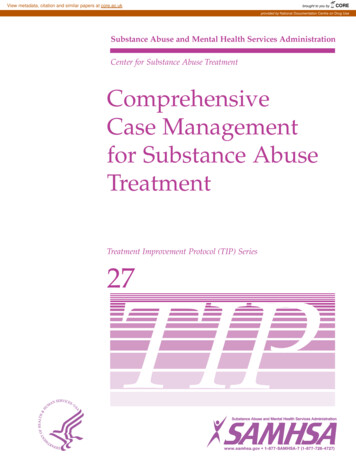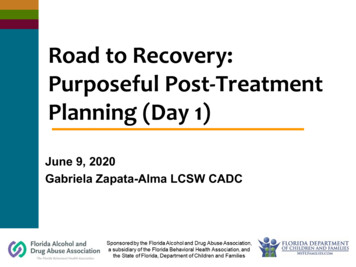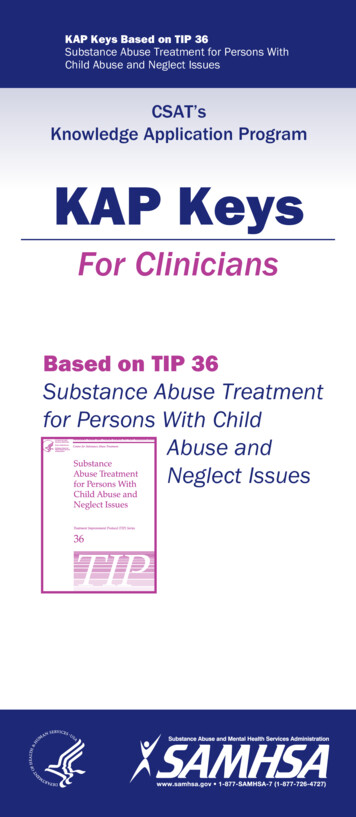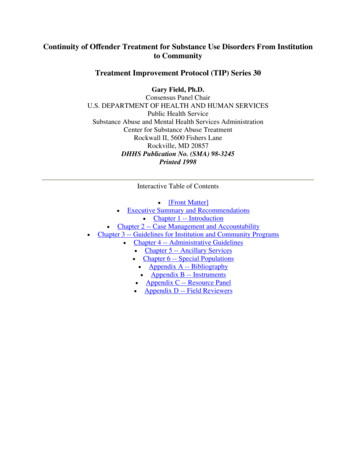
Transcription
View metadata, citation and similar papers at core.ac.ukbrought to you byCOREprovided by National Documentation Centre on Drug UseSubstance Abuse and Mental Health Services AdministrationCenter for Substance Abuse TreatmentComprehensiveCase Managementfor Substance AbuseTreatmentTreatment Improvement Protocol (TIP) Series27
(for spine positioning)Comprehensive Case Management for Substance Abuse TreatmentCSAT (TIP)27Blue Lines FPO
ComprehensiveCaseManagement forSubstance AbuseTreatmentTreatment Improvement Protocol (TIP) Series27U.S. DEPARTMENT OF HEALTH AND HUMAN SERVICESPublic Health ServiceSubstance Abuse and Mental Health Services AdministrationCenter for Substance Abuse Treatment1 Choke Cherry RoadRockville, MD 20857
AcknowledgmentsThis publication was prepared undercontract number 270-95-0013 by theKnowledge Application Program (KAP), aJoint Venture of The CDM Group, Inc., andJBS International, Inc., for the SubstanceAbuse and Mental Health ServicesAdministration (SAMHSA), U.S.Department of Health and Human Services(HHS). Christina Currier served as theGovernment Project Officer.DisclaimerThe views, opinions, and content of thispublication are those of the author and donot necessarily reflect the views, opinions,or policies of SAMHSA or HHS.Public Domain NoticeAll material appearing in this report is in thepublic domain and may be reproduced orcopied without permission from SAMHSA.Citation of the source is appreciated.However, this publication may not bereproduced or distributed for a fee withoutthe specific, written authorization of theOffice of Communications, SAMHSA,HHS.Electronic Access and Printed CopiesThis publication may be ordered for freefrom SAMHSA’s Publications OrderingWeb page at http://store.samhsa.gov. Or,please call SAMHSA at 1-877-SAMHSA-7(1-877-726-4727) (English and Español).The document can be downloaded from theKAP Web site at http://kap.samhsa.gov.Recommended CitationSubstance Abuse and Mental HealthServices Administration. ComprehensiveCase Management for Substance AbuseTreatment. Treatment Improvement Protocol(TIP) Series, No. . HHS Publication No.(SMA) 12-4215. Rockville, MD: Author,2012.Originating OfficeQuality Improvement and WorkforceDevelopment Branch, Division of ServicesImprovement, Center for Substance AbuseTreatment, Substance Abuse and MentalHealth Services Administration, 1 ChokeCherry Road, Rockville, MD 20857.HHS Publication No. (SMA) 12-4215Printed 2012First printed 2000Revised 2002, 2003, 2006, 2008, 2010, DQG 2012
ContentsWhat Is a TIP?. vEditorial Advisory Board. viiConsensus Panel . ixForeword. xiExecutive Summary. xiiiCase Management and Substance Abuse Treatment . xiiiInteragency Case Management . xivEvaluation and Quality Assurance of Case Management Services . xvCase Management for Clients With Special Needs . xviiFunding Under Managed Care .xviiiChapter 1—Substance Abuse and Case Management: An Introduction.1Why Case Management .2Case Management—A Brief History .4Definitions and Functions.5Models of Case Management with Substance Abusers .6Chapter 2—Applying Case Management to Substance Abuse Treatment .13Case Management Principles .13Case Management Practice—Knowledge, Skills, and Attitudes .15The Substance Abuse Treatment Continuum and Functions of Case Management .17Chapter 3—Case Management in the Community Context: An Interagency Perspective .29Characteristics of the Three Models .30Forging the Linkages .33Identifying Potential Partners .35The Agency Environment .36Potential Conflicts .39Chapter 4—Evaluation and Quality Assurance of Case Management Services .41A Brief Overview of the Research Literature .41iii
ContentsEvaluating Case Management Programs.43Future Research.49Chapter 5—Case Management for Clients With Special Needs .51Minority Clients .51Clients With HIV Infection and AIDS.52Clients With Mental Illness.53Homeless Clients.54Women With Substance Abuse Problems .55Adolescent Substance Abusers .57Clients in Criminal Justice Settings .57Clients With Physical Disabilities .62Gay, Lesbian, Transgendered, and Bisexual Clients .63Case Management in Rural Areas .64Chapter 6—Funding Case Management in a Managed Care Environment.65Funding Case Management in a Managed Care World .65Preparing a Program for Managed Care.68Future Directions .71Appendix A—Bibliography.73Appendix B—Practice Dimensions .87Referral .87Service Coordination .90Appendix C—Managed Healthcare Organizational Readiness Guide and Checklist: Special Report.99Introduction .99Goals and Objectives .100Background.100Ways To Use the Guide and Checklist.100Managed Healthcare Organizational Readiness Checklist .104Summary of Answers .111Common Questions and Answers.112How Can We Design an Action Program for Change? .113Summary and Conclusion .113References .114Appendix D—Resource Panel .115Appendix E—Field Reviewers .117iv
What Is a TIP?Treatment Improvement Protocols (TIPs) aredeveloped by the Substance Abuse and MentalHealth Services Administration (SAMHSA)within the U.S. Department of Health andHuman Services (HHS). Each TIP involves thedevelopment of topic-specific best-practiceguidelines for the prevention and treatment ofsubstance use and mental disorders. TIPs drawon the experience and knowledge of clinical,research, and administrative experts of variousforms of treatment and prevention. TIPs aredistributed to facilities and individuals acrossthe country. Published TIPs can be accessed viathe Internet at http://kap.samhsa.gov.Although each consensus-based TIPstrives to include an evidence base for thepractices it recommends, SAMHSA recognizesthat behavioral health is continually evolving,and research frequently lags behind theinnovations pioneered in the field. A major goalof each TIP is to convey "front-line" informationquickly but responsibly. If research supports aparticular approach, citations are provided.v
vi
Editorial Advisory BoardKaren Allen, Ph.D., R.N., C.A.R.N.PresidentNational Nurses Society on AddictionsAssociate ProfessorDepartment of Psychiatry, CommunityHealth, and Adult Primary CareUniversity of Maryland, BaltimoreBaltimore, MarylandRichard L. Brown, M.D., M.P.H.Associate ProfessorDepartment of Family MedicineUniversity of Wisconsin School of MedicineMadison, WisconsinDorynne Czechowicz, M.D.Associate DirectorMedical/Professional AffairsTreatment Research BranchDivision of Clinical and Services ResearchNational Institute on Drug AbuseRockville, MarylandLinda S. Foley, M.A.Former DirectorProject for Addiction Counselor TrainingNational Association of State Alcohol andDrug CounselorsDirectorTreatment Improvement ExchangeHealth Systems Research, Inc.Washington, D.C.Wayde A. Glover, MIS, NCAC IIDirectorCommonwealth Addictions Consultants andTrainersRichmond, VirginiaPedro J. Greer, M.D.Assistant Dean for Homeless EducationUniversity of Miami School of MedicineMiami, FloridaThomas W. Hester, M.D.Former State DirectorSubstance Abuse ServicesDivision of Mental Health, MentalRetardation and Substance AbuseGeorgia Department of Human ResourcesAtlanta, GeorgiaGil HillDirectorOffice of Substance AbuseAmerican Psychological AssociationWashington, D.C.Douglas B. Kamerow, M.D., M.P.H.DirectorCenter for Practice and TechnologyAssessmentAgency for Health Care Policy and ResearchRockville, Marylandvii
Editorial Advisory BoardStephen W. LongDirectorOffice of Policy AnalysisNational Institute on Alcohol Abuse andAlcoholismRockville, MarylandRichard K. Ries, M.D.Director and Associate ProfessorOutpatient Mental Health Services and DualDisorder ProgramsHarborview Medical CenterSeattle, WashingtonRichard A. Rawson, Ph.D.Executive DirectorMatrix CenterLos Angeles, CaliforniaSidney H. Schnoll, M.D., Ph.D.ChairmanDivision of Substance Abuse MedicineMedical College of VirginiaRichmond, VirginiaEllen A. Renz, Ph.D.Former Vice President of Clinical SystemsMEDCO Behavioral Care CorporationKamuela, Hawaiiviii
Consensus PanelChairHarvey A. Siegal, Ph.D.Professor and DirectorSubstance Abuse Intervention ProgramsSchool of MedicineWright State UniversityDayton, OhioWorkgroup LeadersJames A. Hall, Ph.D.Associate ProfessorSchool of Social WorkUniversity of IowaIowa City, IowaHoward Isenberg, M.A.Division DirectorOutpatient Treatment ServicesNortheast Treatment CentersWilmington, DelawareMary NakashianVice President and Director of ProgramDemonstrationNational Center on Addiction and SubstanceAbuse at Columbia University (CASA)New York, New YorkRichard C. Rapp, M.S.W.Co-Investigator, Assistant ProfessorSubstance Abuse Intervention ProgramsSchool of MedicineWright State UniversityDayton, OhioM. Susan Ridgely, M.S.W., J.D.Associate ProfessorDepartment of Mental Health Law andPolicyFlorida Mental Health InstituteUniversity of South FloridaTampa, FloridaPatrick Sullivan, Ph.D.Division DirectorDivision of Mental HealthFamily and Social Services AdministrationIndianapolis, IndianaPanelistsKathleen Andolina, R.N., M.S., C.S.ConsultantCenter for Case ManagementNatick, MassachusettsBarbara A. Blakeney, M.S., R.N., C.S., A.N.P.Principal Public Health NurseLong Island ShelterHomeless Services and Addiction ServicesPublic Health CommissionBoston, MassachusettsElizabeth Garcia, M.S.W.DirectorManaged CarePinal Gila Behavioral Health AssociationApache Junction, Arizonaix
Consensus PanelxMargaret E. Hanna, M.Ed.Executive DirectorBucks County Drug and AlcoholCommissionNew Britain, PennsylvaniaDuane C. McBride, Ph.D.Director of ResearchBehavioral Science DepartmentAndrews UniversityBerin Springs, MichiganAlbert Hasson, M.S.W.Administrative DirectorMatrix Institute on AddictionsPizarro Treatment CenterLos Angeles, CaliforniaSylvia M. Ryan, M.A., B.A.Program DirectorRocky Boy Health BoardRocky Boy Chemical Dependency ProgramBox Elder, MontanaJudith Levy, Ph.D.Associate ProfessorSchool of Public HealthUniversity of IllinoisChicago, IllinoisAnne C. Sowell, A.C.S.W., L.I.S.W.Coordinator of Community ProjectsMiracle VillageMetroHealth Medical CenterCleveland, Ohio
ForewordThe Treatment Improvement Protocol (TIP)series fulfills the Substance Abuse andMental Health Services Administration’s(SAMHSA’s) mission to improve prevention andtreatment of substance use and mental disordersby providing best practices guidance to clinicians,program administrators, and payers. TIPs are theresult of careful consideration of all relevantclinical and health services research findings,demonstration experience, and implementationrequirements. A panel of non-Federal clinicalresearchers, clinicians, program administrators,and patient advocates debates and discusses theirparticular area of expertise until they reach aconsensus on best practices. This panel’s work isthen reviewed and critiqued by field reviewers.The talent, dedication, and hard work that TIPspanelists and reviewers bring to this highlyparticipatory process have helped bridge the gapbetween the promise of research and the needs ofpracticing clinicians and administrators to serve,in the most scientifically sound and effective ways,people in need of behavioral health services. Weare grateful to all who have joined with us tocontribute to advances in the behavioral healthfield.Pamela S. Hyde, J.D.AdministratorSubstance Abuse and Mental Health Services AdministrationPeter J. Delany, Ph.D., LCSW‐C RADM, USPHSDirectorCenter for Substance Abuse TreatmentSubstance Abuse and Mental Health ServicesAdministrationxi
Executive SummaryCase management has been variouslyclassified as a skill group, a corefunction, service coordination, or anetwork of “friendly neighbors.” Although itdefies precise definition, case managementgenerally can be described as a coordinatedapproach to the delivery of health, substanceabuse, mental health, and social services, linkingclients with appropriate services to addressspecific needs and achieve stated goals. TheConsensus Panel that developed this TIPbelieves that case management lends itself to thetreatment of substance abuse, particularly forclients with other disorders and conditions whorequire multiple services over extended periodsof time and who face difficulty in gaining accessto those services. This document details thefactors that programs should consider as theydecide to implement case management ormodify their current case management activities.This summary is excerpted from the main text,in which references to the research appear.Research suggests two reasons why casemanagement is effective as an adjunct tosubstance abuse treatment. First, retention intreatment is associated with better outcomes,and a principal goal of case management is tokeep clients engaged in treatment and movingtoward recovery. Second, treatment may bemore likely to succeed when a client’s otherproblems are addressed concurrently withsubstance abuse. Case management focuses onthe whole individual and stressescomprehensive assessment, service planning,and service coordination to address multipleaspects of a client’s life. Comprehensivesubstance abuse treatment often requires thatclients move to different levels of care orsystems; case management facilitates suchmovement.Any definition of case management will becontextual, depending on who is implementingthe program. Perhaps a more helpful way tounderstand it is to examine the functions thatgenerally comprise case management: (1)assessment, (2) planning, (3) linkage, (4)monitoring, and (5) advocacy.Case Management andSubstance AbuseTreatmentWhen implemented to its fullest, casemanagement will enhance the scope ofaddictions treatment and the recoverycontinuum. A treatment professional utilizingcase management will Provide the client a single point of contact formultiple health and social services systems Advocate for the client Be flexible, community-based, and clientoriented Assist the client with needs generallythought to be outside the realm of substanceabuse treatmentxiii
Executive SummaryTo provide optimal services for clients, atreatment professional should possess particularknowledge, skills, and attitudes including Understanding various models and theories of addiction and other problems related tosubstance abuseAbility to describe the philosophies,practices, policies, and outcomes of the mostgenerally accepted and scientificallysupported models of treatment, recovery,relapse prevention, and continuing care foraddiction and other substance-relatedproblemsAbility to recognize the importance of family,social networks, community systems, andself-help groups in the treatment andrecovery processUnderstanding the variety of insurance andhealth maintenance options available and theimportance of helping clients access thosebenefitsUnderstanding diverse cultures andincorporating the relevant needs of culturallydiverse groups, as well as people withdisabilities, into clinical practiceUnderstanding the value of aninterdisciplinary approach to addictiontreatmentIn addition to the above competencies,treatment professionals must have skills relatingto interagency functioning, negotiating, andadvocacy. CSAT’s Addiction TechnologyTransfer Centers classify referral and servicecoordination—basic case managementfunctions—as core competencies for substanceabuse treatment providers.The Substance Abuse TreatmentContinuum and Functions of CaseManagementThe continuum of substance abuse treatmentranges from case finding and pretreatment toprimary treatment to aftercare. Although therexivare distinct goals and treatment activities at eachpoint on the continuum, rarely do clients’ needsfit neatly into any one area at a given time; casemanagement serves to span client needs andprogram structure. Substance abuse treatmentand case management functions differ in thattreatment involves activities that help substanceabusers recognize their problems, acquire themotivation and tools to stay abstinent, and usethe acquired tools; case management focuses onhelping the substance abuser acquire neededresources. Case management supports a clientas he moves through the recovery continuumand reinforces treatment goals.Interagency CaseManagementThe goal of interagency case management is toexpand the network of services available toclients. All organizations have boundaries towhat they can do, and case managers or“boundary spanners” transcend them tofacilitate interactions among agencies. In thefield of substance abuse, three interagencymodels have been identified. In the single agencymodel, the case manager personally establishesa series of distinct relationships on an as-neededbasis with counterparts in other agencies. In theinformal partnership model, staff members fromseveral agencies work as a collaborative team,often constituted case by case; the formalconsortium binds case managers and serviceproviders through formal written agreements.Clearly defined roles are essential to all threemodels to ensure that services are coordinatedand relevant gaps addressed.Although informal exchange or “socialservice bartering” among different agencies isintrinsic to case management, a more formalizedconnection among agencies sometimes may berequired. Examples include memoranda ofunderstanding and interagency agreements andcontracts; each of these methods for formalizing
Executive Summaryexpectations can be used in single agencymodels, informal partnerships, and formalconsortia.To be successful, a case management planmust thoroughly and critically examinecommunity resources to determine what formsof assistance are available and how casemanagement efforts can help clients attainnecessary assistance. Many communities havepublished directories of social, health, welfare,housing, vocational, and other serviceorganizations to help case managementprograms identify resources, possible providerlinkages, and potential gaps in services for theirclients. Although such directories are a goodstarting point, it is important to follow up on thelistings to ensure they are still accurate and willbe of use to the client.The Environmental AssessmentExploring the environment in which an agencyoperates is crucial to determining the feasibilityof an interagency effort. Analysis of thecommunity environment will enhanceunderstanding of the changes that occur amongclients, within the program, and in thecommunity. Case management takes placewithin a dynamic social service environment inwhich agencies are in constant flux. Programsconsidering interagency efforts must devisestrategies to respond to change while providingcontinuity for the client. Regular reevaluationhelps ensure continued relevance; communityservice provider networks or consortia areparticularly effective in sharing informationabout changes and developments.Potential ConflictsWhenever agencies or service providers worktogether, the potential for conflict exists. Areasof tension may be present from the very onset ofthe collaboration. For example, a new projectmay be viewed by established social serviceagencies as competition for scarce resources.Sometimes social pressures or the need tomaximize resources can force public agenciesinto joint ventures even if they do not mesh wellor have a history of being service competitors.Tensions can also develop in the course ofdelivering services; for example, interagencycollaboration may result in a client having twocase managers. Recognizing potential triggersfor conflict is a necessary first step in developinga system to handle them. When problems doarise, case managers and other agency personnelcan use both informal and formalcommunication to clarify issues, regainperspective, and refocus the interagency casemanagement process.Evaluation and QualityAssurance of CaseManagement ServicesSubstance abuse treatment programs, includingthose that receive public funding, areincreasingly operating in a managed careenvironment. In such an environment, policyand clinical decisionmaking rely on outcomedata that traditionally describe the impact ofcase management and substance abusetreatment interventions in the context of servicesused and money spent. An additional demandfor data comes from public and private payerswho want services linked to specific outcomes.To gauge the effectiveness of casemanagement, indicators of “success” must bedefined by the substance abuse program and itsstakeholders (including funding and regulatoryagencies). In documenting a case managementeffort, it is necessary to establish benchmarks tomeasure the case management process, forexample, recording how often a client shows upat treatment. Once the benchmarks are definedin measurable terms, the next step is to developand implement a method for measuringpractice; that is, to answer the questions, “Whatare case managers doing, and how does theirxv
Executive Summarypractice conform to the benchmarks?” Methodsof such documentation include Maintenance of a simple staff log procedurethat measures case managers’ activities bycontact Reviews of case manager client records toevaluate how service planning and referralsadhere to benchmarks Interviews or surveys of case managers orclients and their family members to collectinformation on activities in which casemanagers engage, to identify how clients’and case managers’ views of casemanagement activities differ Analysis of data from the agency’smanagement information system (to examinepatterns on type, number, and duration ofcase manager contacts with different targetpopulations).Measuring System OutcomesSystem outcomes are particularly important in amanaged care environment, where overall useof expensive services such as hospitalization andresidential treatment is strictly monitored.System outcomes can measure cost savings andquality of care: For example, continuity of care isan appropriate measure for a client at risk forrelapse after detoxification and before entry intooutpatient treatment. Tracking clients within acomprehensive service agency or analyzing dataon costs and encounters within a network ofagencies are two methods for measuring systemoutcomes. For such analyses, a computerizedmanagement information system (MIS) isessential.Measuring Client OutcomesAlthough “evaluation” is generally consideredworthwhile, there is little agreement about themeasurement and documentation of specificoutcomes for individual clients. Some view asingle measure such as sobriety to be the onlymeaningful indicator of success; others believexvisuccess should be gauged against a range offactors, including reduced substance use,improved family functioning, and fewerencounters with the criminal justice system.Until the debate is resolved, programs shouldidentify treatment objectives and extrapolatefrom them the outcome variables they want tomeasure.Anticipating Quality AssuranceData NeedsThe types of data required for an evaluation ofcase management, how the data are collected,and the manner in which data are put to usevary among different stakeholders. It isimportant to understand the types of data thatvarious stakeholders need to evaluate theprogram. Structured feedback loops should beestablished to ensure that the gathered data arereturned to various stakeholders in somemeaningful way so that they have an impact onshaping future program development (andfuture data needs). One of the benefits of thecase management approach is that it can beadapted to meet the sometimes contradictorynee
Case Management for Substance Abuse Treatment. Treatment Improvement Protocol (TIP) Series, No. . HHS Publication No. (SMA) 12-4215. Rockville, MD: Author, 2012. Originating Office Quality Improvement and Workforce Development Branch, Division of Services Improvement, Center for Substance Abuse Treatment, Substance Abuse and Mental










